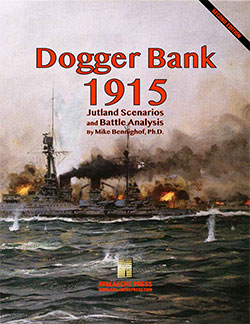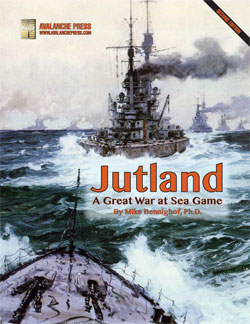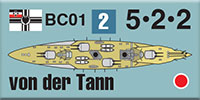Jutland: Dogger Bank
Author’s Notes
by Mike Bennighof, Ph.D.
December 2023
 Great War at Sea: Jutland Second Edition is a new game based on our best-selling first edition, and we’re supporting its release with even more history and game play. When I decided to totally replace the first edition Jutland scenario set with completely new ones focused tightly on the Battle of Jutland, I knew it would leave a great deal of the North Sea naval war no longer covered by the game. Fortuitously, we had a pair of analysis books that added a vast number of new scenarios to fully flesh out the early campaigns in the North Sea. Great War at Sea: Jutland Second Edition is a new game based on our best-selling first edition, and we’re supporting its release with even more history and game play. When I decided to totally replace the first edition Jutland scenario set with completely new ones focused tightly on the Battle of Jutland, I knew it would leave a great deal of the North Sea naval war no longer covered by the game. Fortuitously, we had a pair of analysis books that added a vast number of new scenarios to fully flesh out the early campaigns in the North Sea.
Jutland: North Sea takes the scenarios from the old Jutland Battle Analysis, adds the early 1914 scenarios from Jutland’s first edition, plus some new ones to give the full story of naval operations in the North Sea from August through December 1914. It has 43 scenarios, because there was a lot of action, both undertaken and planned, during those early months when it seemed that the naval war could actually reach a decisive surface battle.
Jutland: Dogger Bank picks up the story with two chapters of 1914 action: the Cuxhaven Raid, in which British seaplane carriers launched a strike against German zeppelin sheds, and British plans for assaults on Helgoland or the Frisian Islands.
After that, we move into the preliminaries for the title event, the Battle of Dogger Bank. This would be the first battle between dreadnought-type ships, and one of only two surface battles in the North Sea fought by such ships. As such it’s worthy of a lot of analysis, since both sides drew many lessons from the battle. For example, the near-loss of flagship Seydlitz caused the Germans to restrict ammunition handling, while the British put even greater emphasis on rapid fire, making them even more lax in filling their handling rooms with shells (leading to multiple losses of battle cruisers at Jutland, and near-loss of another plus a fast battleship to the same causes).
 The Germans matched three battle cruisers and one large armored cruiser against five British battle cruisers. The British sank the armored cruiser Blücher and chased the Germans off, scoring a notable victory. It’s an interesting battle in a number of respects, and the analysis-book format lets us break it down and look at it from several angles. The Germans matched three battle cruisers and one large armored cruiser against five British battle cruisers. The British sank the armored cruiser Blücher and chased the Germans off, scoring a notable victory. It’s an interesting battle in a number of respects, and the analysis-book format lets us break it down and look at it from several angles.
First, there’s some questionable decision-making, particularly by German scouting forces commander Franz Hipper (he would not receive a “von” until after the Battle of Jutland in 1916). Should he have brought Blücher along? Should he have waited for the battle cruiser von der Tann to complete repairs, or cancelled them and taken her along? We can use the scenarios to study how different decisions might have affected the outcome.
And second, there are the decision points during the operation. We have an operational scenario covering the whole operation, and a battle scenario for the battle. And we also have two more scenarios allowing you to pick up the action at key points, and battle scenarios for the surface actions that might have arisen. In the full scenario, with players having the option to make different decisions than Hipper and Sir David Beatty, it’s not likely that these precise situations would appear. But this way, you can make the crucial decisions.
And then there are the alternative orders of battle: ships that could have been present at Dogger Bank, but were not for various reasons. Would they have made a difference? We let you answer that question. All told we devote ten scenarios to the Battle of Dogger Bank, plus plenty of historical and analysis text. This is as thorough a look at the battle as we can create.
The defeat at Dogger Bank cost High Seas Fleet commander Friedrich von Ingenohl his job. The Kaiser passed over Reinhard Scheer of Third Battle Squadron and gave command to Hugo von Pohl. Pohl had been Chief of the Admiralty Staff, and there had agitated for unrestricted submarine warfare, which took effect two days after he assumed command of the High Seas Fleet. Unwilling to risk the fleet while the submarines took up the offensive burden, Pohl restricted operations to the very south-eastern corner of the North Sea.
 In all, the High Seas Fleet set out five times after Dogger Bank and before Pohl’s relief in January 1916 following a diagnosis of liver cancer. The brief sorties never encountered the British, and did little to relieve the boredom of the crews or quench their thirst for action. Lower-deck discipline began to slip even in the elite Scouting Groups. In all, the High Seas Fleet set out five times after Dogger Bank and before Pohl’s relief in January 1916 following a diagnosis of liver cancer. The brief sorties never encountered the British, and did little to relieve the boredom of the crews or quench their thirst for action. Lower-deck discipline began to slip even in the elite Scouting Groups.
That’s a story that’s never, to my knowledge, been told in wargame form and has not fully explored in English-language historiography. To get to the details of those operations, you have to dig pretty deeply. Which is exactly the sort of thing I love to do.
There would be no surface actions, or any near-encounters that might have led to them, during the fifteen months between the January 1915 Battle of Dogger Bank and the April 1916 Lowestoft Raid. Pohl kept the fleet close to its bases while the submarines that could have countered British superiority in heavy ships were off loosing torpedoes at merchantmen. The zeppelins that could have given warning of the approaching Grand Fleet had launched their first bombing raid on Britain just five days before the Battle of Dogger Bank.
In practice, neither of those new and innovative naval service branches lived up to their supposed potential when finally deployed by Scheer in 1916. But Pohl did not know that, and hesitated to enter the North Sea without their assistance. He doubtlessly also suffered from the cancer that would eventually kill him.
Like Ingenohl before him, Pohl led an inferior fleet. The first two classes of German dreadnoughts were poor fighting ships and the third at best mediocre. Only the König class and later the Baden class could be considered comparable to British ships of the same period. It would take a man more comfortable with risk than Hugo von Pohl to attempt to find the mis-match pitting the High Seas Fleet against a single British squadron that appeared at the time - and seems confirmed by hindsight - to be the only realistic chance for a German victory at sea.
I wrote the first editions of Jutland: North Sea 1914 and Dogger Bank 1915 mostly as a personal indulgence. Historical veracity was always important to me as a game designer, but most of that consisted of small things (a special unit there, a special rule here) that almost certainly were evident only to me. The analysis books put that aspect in the foreground, and even though most wargamers appear to prefer “more games, more fast, damn the history,” they’ve been the most popular books we’ve published, and that deeply satisfies me as their author.
You can order North Sea 1914 right here.
You can order Jutland: Dogger Bank right here.
The Jutland Experience
 Jutland Second Edition (full game) Jutland Second Edition (full game)
Jutland: North Sea 1914
Jutland: Dogger Bank
Journal No. 46: Iron Dogs
Retail Price: $179.96
Package Price: $150.00
Gold Club Price: $120.00
You can order the Jutland Experience right here.
Please allow an extra two weeks for delivery.
Sign up for our newsletter right here. Your info will never be sold or transferred; we'll just use it to update you on new games and new offers.
Mike Bennighof is president of Avalanche Press and holds a doctorate in history from Emory University. A Fulbright Scholar and NASA Journalist in Space finalist, he has published a great many books, games and articles on historical subjects; people are saying that some of them are actually good.
He lives in Birmingham, Alabama with his wife, three children, and his new puppy. His Iron Dog, Leopold, could swim very well.
Want to keep Daily Content free of third-party ads? You can send us some love (and cash) through this link right here.
|
